

Spelling Brain Teasers for Kids. These brain teasers for kids require students to read each clue very carefully and understand its meaning.
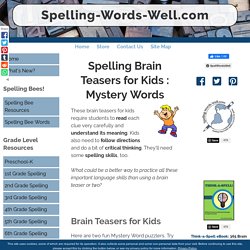
Kids also need to follow directions and do a bit of critical thinking. They'll need some spelling skills, too. – CUNY-NYS Intiative On Emergent Bilinguals. 50. Rethinking Push-In Pull-Out (PIPO): The Cause for Sheltered Co-Teaching. This article on co-teaching as an alternative to the push-in and pull-out program of instructing ELLs is part 8 of the Collaboration for ELLs Series.
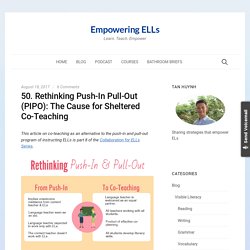
Abandoning an Antiquated Model. Teaching Scenarios. The following is a series of ESL Scenarios submitted by educators.
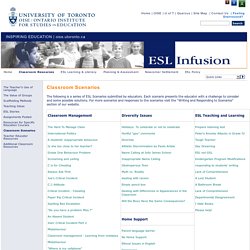
Each scenario presents the educator with a challenge to consider and some possible solutions. For more scenarios and responses to the scenarios visit the "Writing and Responding to Scenarios" section of our website. Contributions from TESL Ontario Members The following scenarios address situations involving ESL students and were created by teachers and administrators attending the 2001 TESL Ontario annual conference.
We invite you to read these scenarios, post possible ways of addressing the situations described, and post further scenarios of your own. Scenario #1: Accommodate or Not? An ESL student who was in your class a year ago tells you that the teacher in her mainstream senior English course is unwilling to make any accommodations to the course content or delivery in order to facilitate her learning (e.g., allowing extended test taking time). Language Acquisition Difficulty or Learning Disability? How to Differentiate and Support English Language Learners with a Learning Disability - LD@school. Add to favorites Summarized by Cindy Perras, M.Ed., OCT Educational Consultant, LDAO Introduction.
Observable Language Behaviours (OLB) Continua – STEP Training. The OLB continua serve as the main assessment and tracking tool of the STEP resource, which support the progress of ELL, and inform programming decisions.
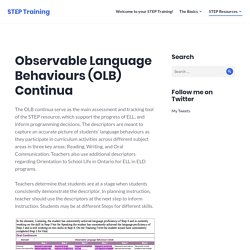
The descriptors are meant to capture an accurate picture of students’ language behaviours as they participate in curriculum activities across different subject areas in three key areas: Reading, Writing, and Oral Communication. Teachers also use additional descriptors regarding Orientation to School Life in Ontario for ELL in ELD programs. Teachers determine that students are at a stage when students consistently demonstrate the descriptor. In planning instruction, teacher should use the descriptors at the next step to inform instruction.
Students may be at different Steps for different skills. English as a Second Language Observable Language Continua. Knowledge Structures. Knowledge Structures. Increasing Academic Language Knowledge for English Language Learner Success. In college I enrolled at a university in Spain — all courses were taught in Spanish.
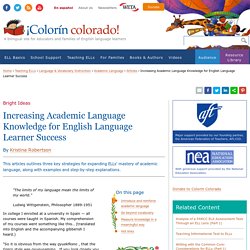
My comprehension of my courses went something like this… (translated into English and the accompanying gibberish I heard.) "So it is obvious from the way qyuekfksno , that the Greco style was qyueuoammo . If you look closely you notice xawoeirje and it reminds you of woieysksdufe . " The only clue I had to aid my comprehension was a slide of the famous painting. I struggled to make meaning of the language, but I could not comprehend the professor's points. I believe many ELL students have a similar experience in their classes, and that many of them are able to manipulate the English language to supply a correct answer, but still not understand the content. Academic Language Function Toolkit.pdf: ELD Professional Development Common Core. Checklists, Rating Scales and Rubrics (Assessment) Assessment Strategies and Tools: Checklists, Rating Scales and Rubrics Checklists, rating scales and rubrics are tools that state specific criteria and allow teachers and students to gather information and to make judgements about what students know and can do in relation to the outcomes.
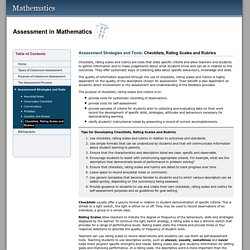
They offer systematic ways of collecting data about specific behaviours, knowledge and skills. The quality of information acquired through the use of checklists, rating scales and rubrics is highly dependent on the quality of the descriptors chosen for assessment. Their benefit is also dependent on students’ direct involvement in the assessment and understanding of the feedback provided. The purpose of checklists, rating scales and rubrics is to: STEP Flow Chart – Overview. Self and peer assessment resources / Self and peer assessment / Assessment for learning in practice / Assessment for learning / Home - Assessment.
Peer feedback for ESL classrooms - Peergrade - engaging student peer review. Peer feedback for ESL classrooms Teaching English as a Second Language (ESL) is both uniquely rewarding and challenging.
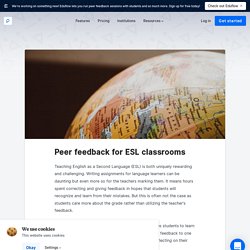
Writing assignments for language learners can be daunting but even more so for the teachers marking them. It means hours spent correcting and giving feedback in hopes that students will recognize and learn from their mistakes. But this is often not the case as students care more about the grade rather than utilizing the teacher’s feedback. Using a peer assessment tool like Peergrade encourages students to learn by teaching their peers. But can ESL students truly offer each other helpful feedback? The short answer is Yes! Using peer feedback effectively in an ESL classroom. 10 - Peer and self assessment in student work: principles and criteria - Teaching Quality Assurance Manual.
Introduction Self and peer assessment are important aspects of ‘assessment for learning’ practice.

Assessing their own work or that of others can help students to develop their understanding of the Intended Learning Outcomes and the Assessment Criteria. Rubric Design for Learning and Language Objectives - Grading with the ELL in Mind. 15 Culturally-Responsive Teaching Strategies. No single teaching approach will engage each student at once, but building a strategy to consistently deliver culturally-responsive lessons will help you appeal to diverse learners with distinct backgrounds. English as an Additional Language (EAL) What's New!
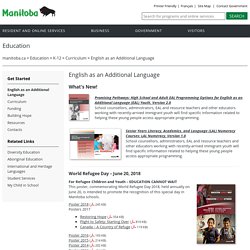
Promising Pathways: High School and Adult EAL Programming Options for English as an Additional Language (EAL) Youth, Version 2.0 School counsellors, administrators, EAL and resource teachers and other educators working with recently-arrived immigrant youth will find specific information related to helping these young people access appropriate programming. Senior Years Literacy, Academics, and Language (LAL) Numeracy Courses: LAL Numeracy, Version 1.0 School counsellors, administrators, EAL and resource teachers and other educators working with recently-arrived immigrant youth will find specific information related to helping these young people access appropriate programming.
World Refugee Day – June 20, 2018 For Refugee Children and Youth – EDUCATION CANNOT WAIT This poster, commemorating World Refugee Day 2018, held annually on June 20, is intended to promote the recognition of this special day in Manitoba schools. 15 Culturally-Responsive Teaching Strategies. Greening ESL (English as a Second Language) Greening English as a Second Language happens when we integrate environmental and sustainability issues, ideas and activities into English as a Second Language lessons.

Whether you're working with adult students overseas, teaching youngsters who are new to your English-speaking country, or something in between,greening English as a Second Language is easy. Greening ESL is an approach that "will readily appeal to second language learners concerned with finding a more relevant, interesting and socially significant focus for their efforts at second language acquisition than they may be used to encountering.... Environmental education can prove a rich source of material for purposeful language learning. "— George M. Because there might not be a set curriculum for ESL, these classes offer a perfect opportunity to teach environmental and sustainability awareness. (269) Cultures of learning - vital feature of international education. How Parent Involvement Leads to Student Success.
Education How Parent Involvement Leads to Student Success November 1, 2018 Subscribe Share on facebook Share on twitter Share on pinterest What’s the most accurate predictor of academic achievement? When parents are engaged in their children’s school lives, students have the home support and knowledge they need to not only finish their assignments, but also develop a lifelong love of learning. Teachers who focus on parent engagement often see a profound change in their classrooms.
Encouraging parent engagement is more than common courtesy. What is Parent Engagement? According to experts, the definition of parent engagement is parents and teachers sharing a responsibility to help their children learn and meet educational goals. Parental-Youth Communication. How to use "inset" in a sentence. Creating a Welcoming Classroom Environment. Chances are that your English language learners (ELLs) come from a culture with traditions and family values that differ from mainstream American culture.
These young children not only have the challenge of learning a new language, but also of adjusting to an unfamiliar cultural setting and school system. Imagine what it would be like to step into a foreign classroom where you didn't understand the language, rules, routines, or expected behavior. On a daily basis, ELLs are adjusting to new ways of saying and doing things. As their teacher, you are an important bridge to this unknown culture and school system. There are a number of things you can do to help make ELLs' transitions as smooth as possible. Stages of cultural accommodation. Foreign Language Teaching Methods: The Language Learner.
Ways to Decrease Anxiety In the previous lessons, current research about the widespread phenomenon of foreign language anxiety was summarized. Still, many teachers believe that some degree of anxiety is actually good for learning, including language learning. This raised the question: How much anxiety is good for learning and when does it become detrimental? Lv/lv-03-03-teaching-1.xml Is some anxiety good?
Duration: 01:30 While some anxiety increases adrenalin and actually facilitates performance, too much anxiety greatly hampers performance (e.g., the well-known phenomenon of a student who "goes blank" when called on by the teacher). Brainstorm a few practical techniques to reduce your students' anxiety. Attack Negative Thoughts.